How to Open a Young Coconut
Young coconuts are where you find coconut water – an excellent source of potassium, manganese, magnesium, phosphorus, riboflavin and thiamin. It’s also low in calories, contains no cholesterol and is a source of calcium, it’s one of my favorite post-run beverages.
A young coconut is not to be confused with a mature coconut – the brown hairy nut we all know and love. (Yes, we’re still talking about coconuts here.) The beautiful thing about a young coconut is the coconut water. The water turns to “milk” and the the fat content of the liquid increases with time, as the coconut matures.
Coconut water is loaded with electrolytes, has more potassium than you can shake a banana at – it’s like all you could want from a sports drink and more.
Young coconuts are a little tricky though. For one, they can be hard to find. Once you do locate a store that carries them, the next battle is getting them open! But like most good things in life, they are worth the effort to find them and get them open too.
I can sometimes find young coconuts in the produce section in my local grocery store with the mature coconuts. I’ve also found them at large health food stores and the Asian market as well.
Once you get your mitts on one, you need a big knife or hatchet to crack into it.
I prefer the “big knife” route, as it seems like I’m less likely to lose a finger or hand in the process of getting it open than if I use a hatchet.
Along with a big knife, a rubber mallet can allow you sink the knife in far enough to get through the outer shell without having to worry about your aim and where the knife is going to land – because without the mallet you’re going to have to start with the knife behind your head to work up enough speed and force to get into it.
Start by pushing the knife into the soft outer shell, and then give the knife a few good whacks with your mallet to sink the blade into the nut.
Work your way around the top “point” of the young coconut until you’ve made your way all around to where you began.
You might have to go around again, putting the knife back into the cuts you’ve already made to go a little deeper.
Once you’ve dug in deep enough, you should be able to pry the top off – prepare yourself as you’re about to hit the coconut water jackpot!
After you empty the coconut of water, you are left with a relatively thin layer of soft coconut meat that you can scrape out and use immediately or save for later.
The meat can be used in soups and Thai dishes, but my favorite thing to do with young coconut meat is make a smoothie!
My favorite smoothie combo is the meat of one young coconut, a sliced, slightly frozen banana (only slightly frozen for the sake of my blender) and milk of your choice – I prefer non-dairy and usually use unsweetened vanilla almond or hemp milk.
No additional sweeteners needed, this is the perfect combo of flavors!
You can find packaged coconut water in health food stores, but in my experience it’s cheaper and has a more full bodied flavor when you get it right from the source.
Hack in to one today!
Back to How To page.

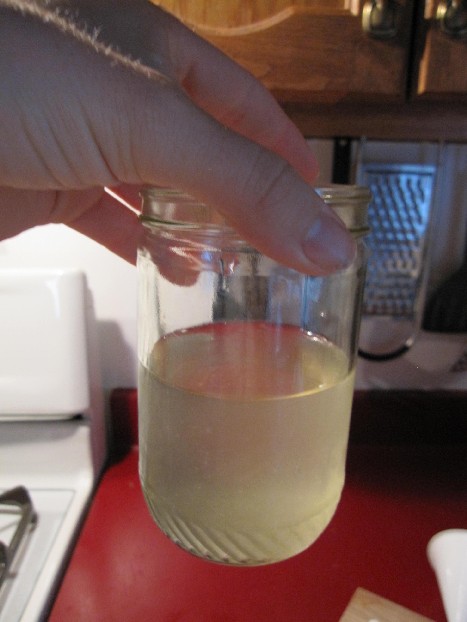
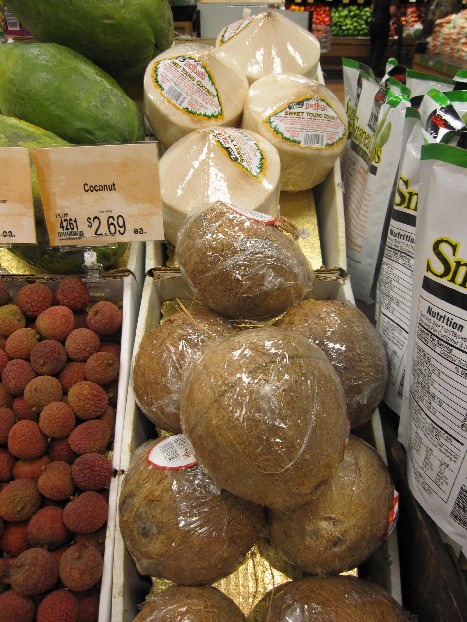

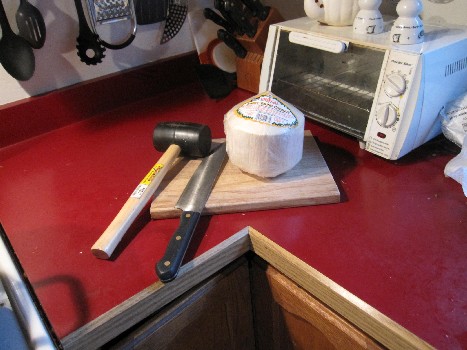
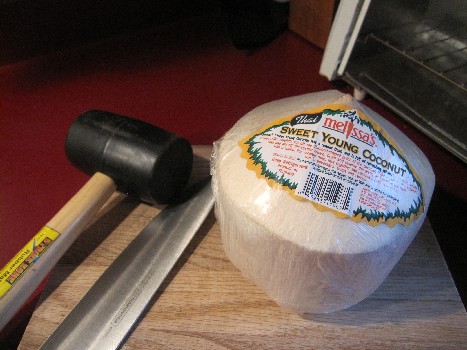
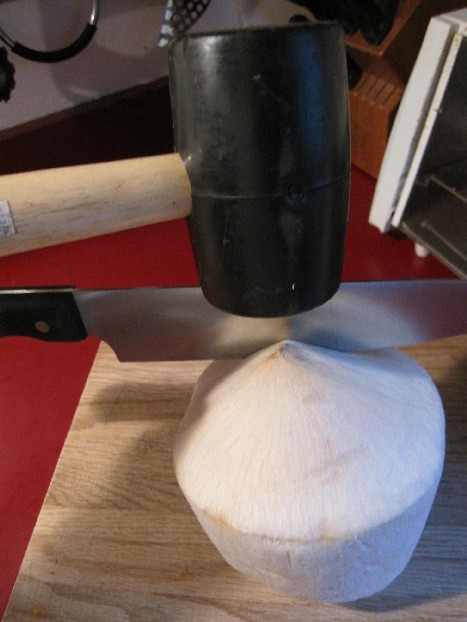
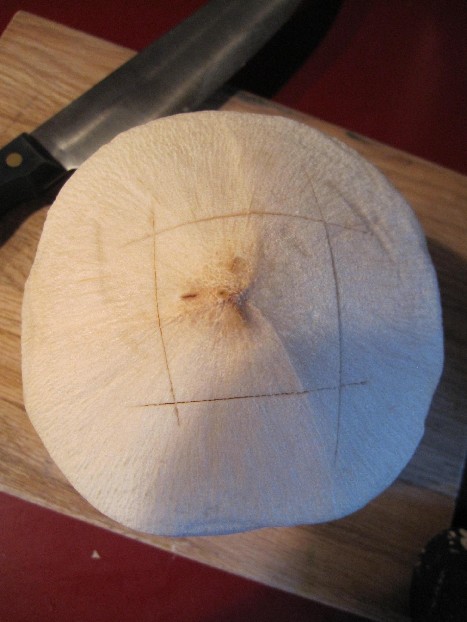
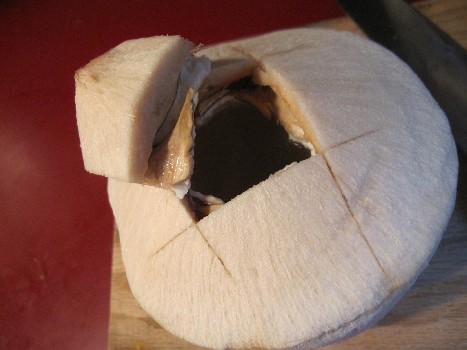
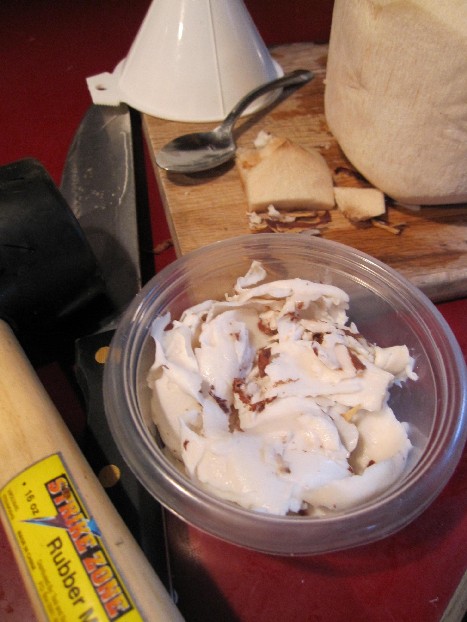

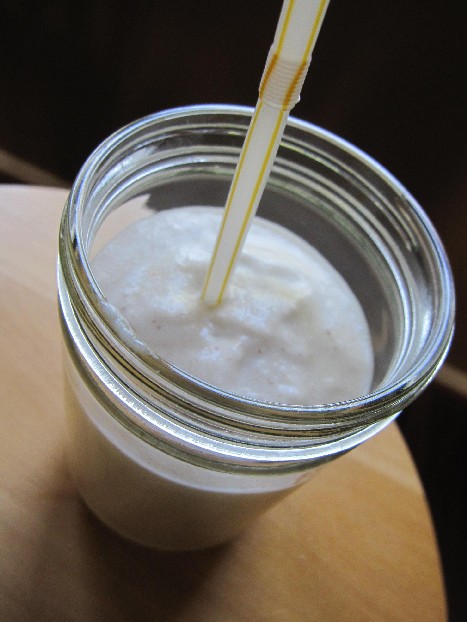



Thank you ,
This was the most helpful demonstration that I found and led me to the rest of you knowledge.
Blessings,
Barbara
I’m glad you found it helpful Barbara! Thanks for your comment. 😉
That is AWESOME!! Can’t wait!
Your explanation and pictures were the best help I’ve found on this. Thanks for being so thorough and informative. One question – is there anything that can be done with the soft, outer shell (besides composting it)? P.S. Thanks for the smoothie recipe, too!
Lorraine, there probably is (young coconut bra anyone?) but all I’ve ever done is throw it in the compost – and believe me when I tell you those suckers take a LONG time to break down! Sorry I’m not more help with that one, but glad this was helpful!
Thank you! I had broken off the top with my cleaver and drained the juice, but for the life of me, I couldn’t remember how I got the coconut meat out of its shell… looking at it, the hole wasn’t big enough and my cleaver and I wasn’t doing the job correctly… we were starting to have a scattered mess… so I went to the internet – I found you and saw your rubber hammer – ding ding ding! lol… I remembered… Boy, getting old it not fun! Have a fantastic day you smart girl you! [SMILE]
Oh, and BTW – the ‘Almond Breeze’ that you use (above, in your photos) is full of chemicals… and chemicals stunt growth… believe me, saying ‘stunt’ is a nice way of putting it… Since you open and make your own products with coconut – which isn’t so easy – you ought to look into making your own almond milk.
It’s not hard at all – just make sure you get raw almonds, soak them over night – I find that it is much easier to blend them in water after they have been soaked since they soften and you are more likely to get a milkier consistency. Its been said (i dunno’ – not a food scientist [SMILE]) that this also removes/deactivates enzyme inhibitors in the nuts, which interferes with digestion – SO, in either case, soaking covers both schools of thought…
I blend soaked almonds with filtered water – stain in a bag – I buy these paint strainer bags from the hardware store – just wash ’em, they’re fine to use and this makes it simple… and you have milk… you can add vanilla if you want – make sure its organic or scrape out a vanilla bean and add…
If you have a dehydrator, you can dry the filtered almonds that was left over from the milk and use it for baking or, as I do, a ‘healthy’ filler in meatloaf, instead of bread crumbs… it’s good – well I hope I didn’t overstep my bounds… Have a fantastic and healthy day!
Hey thanks Xan! I don’t do much almond milk these days, but I’ve never tried making my own. Thanks for the tips!
Naturally refreshing, coconut water has a sweet, nutty taste. It contains easily digested carbohydrate in the form of sugar and electrolytes. Not to be confused with high-fat coconut milk or oil, coconut water is a clear liquid in the fruit’s center that is tapped from young, green coconuts.^;’`
Cheers
http://homeimprovementstuffs.com
I have found to do the opposite in regards to opening the coconut much easier. If you shear away the flat bottom with a cleaver, you will get to a nice soft spot on the hard inner nut. You can easily press it in with your finger or even use a tool as soft as a butter knife to get at the water. I then use a hammer to crack the entire apparatus open to get at the meat once im finished sucking down all the water.